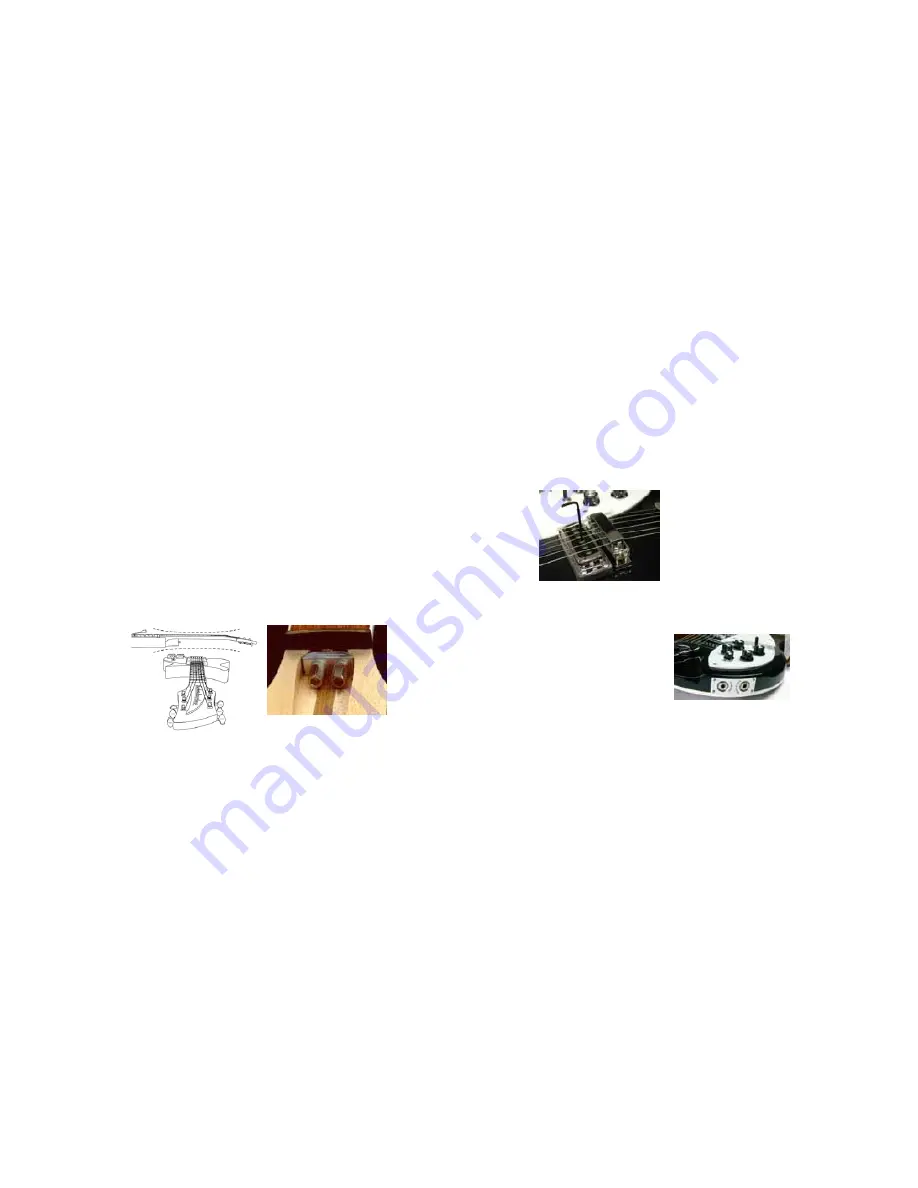
during use.
Neck Adjustment
Most Rickenbacker guitars and
basses are reinforced with twin
truss rods. This exclusive design
gives greater strength and stability
to the neck of the guitar. The truss
rods are separately adjustable,
allowing either side of the neck to
be readjusted independently of the
other, should it become necessary.
Three indications that the neck
may require adjustment are: 1) the
strings begin to buzz against the
frets; 2) the action of the strings
seems too high; or 3) the truss
rods rattle.
With the instrument in tune, sight
the neck for a bow or under-bow by
resting the body on a level table at
an approximate 45 degree angle
holding the top horn near the strap
bolt.
Do not hold by the neck or head,
as doing so will change the actual
position of the neck.
Should adjustment be necessary,
take the strings out of the nut
grooves to allow room to remove
the nameplate from the head of the
instrument. After replacing strings
to the grooves of the nut, retune
the instrument to assure normal
tension on the neck.
Repeat the sighting step to confirm
the amount of bow or under bow in
the neck. Using 1/4 inch nut driver
wrench, such as the NW1 neck
adjustment tool, turn only a half a
turn at a time. Turn the nut clock-
wise to correct an under bow,
counterclockwise to straighten an
over bow. Continue this until the
desired angle of the neck is ob-
tained.
A slight under bow (relief) is com-
mon on non-Rickenbacker instru-
ments due to their limited range of
adjustment. Due to their extreme
adjustability you may prefer to
adjust a RIC neck almost dead
straight depending on the playing
action preferred.
Finally, replace the nameplate and
tune the instrument.
On instruments produced before
September 1, 1984, first loosen the
truss rod nuts, then move the neck
manually to the desired position
and snug the rod up to hold that
position. Do not rely on the rod
itself to provide the bowing force.
This advice actually applies to all
guitar truss rod systems. Adjust-
ments other than these can seri-
ously damage your instrument.
Do not use a socket drive or T-
handle wrench as damage may
occur. Nut driver tools generally
will slip in your hand prior to truss
rod damage, while these tools can
easily permit excessive force to be
applied.
Pickup Adjustment
In order to achieve more volume by
placing the pickup closer to the
strings, guitar and bass pickups
are height adjustable. Both sides of
the pickup may be raised or low-
ered to change overall volume.
Just one of the instrument pickups
may be adjusted in order to change
the relative output of the pickups,
or just one side of any pickup may
be adjusted for changing the vol-
ume of certain strings with respect
to the others. To do this set the
pickup at an angle.
All Rickenbacker pickups are
adjusted by two screws, one on
each side of the pickup. For the
standard high gain and super high
gain Rickenbacker pickups which
are mounted on a piece of flexible
foam rubber, as on series 300 and
600 guitars, only the middle screw
of the three screws on each side of
the pickup is used for readjust-
ment. To lower the pickup, simply
tighten down each of the two
screws clockwise. To raise the
pickup, loosen both screws coun-
terclockwise.
Additionally, all Rickenbacker
standard “Hi-Gain” pickups cur-
rently have individually adjustable
polepieces. Using the 3/32” hex
wrench included with your instru-
ment, gently turn the individual
polepiece to raise or lower it. This
allows the player to fine-tune the
balance between strings, should
there be any inconsistency.
Better balance adjustment is usu-
ally achieved by lowering poles on
strings that are too loud rather than
raising those that are too soft. The
entire pickup assembly may be
raised closer to the strings to
increase overall volume after such
adjustment.
The bass pickup on the 4000
series models is mounted on to the
top pick plate of the instrument.
These pickups have just one screw
on each side, and are adjusted in
the opposite manner. To lower the
pickup, loosen the two side screws
counterclockwise. To raise the
pickup, tighten the screws clock-
wise.
Do not attempt to adjust the pole
pieces (screw-like studs in the
center of the pickup) on older
Rickenbacker high gain pickups
not equipped with hex socket
polepieces. These are set at the
factory, and any attempt to adjust
them can cause permanent dam-
age to the pickup.
Rick-O-Sound
Many Rickenbacker instruments
come equipped with two output
jacks. The jack labeled “Standard”
uses a typical ¼ instrument cable
for normal mono use. The other
jack is a Rick-O-Sound effects
output. This feature allows for
separate output of the bass and
treble position pickups, in conjunc-
tion with a quality stereo Y-cable. It
is also designed for use with a
stereo equipped amplifier.
Rick-O-Sound can be used to
produce special effects and mul-
tichannel output when used with a
stereo amplifier, a dual channel
amplifier, or two separate amplifi-
ers. Additionally, Rick-O-Sound
can produce many other
sounds with the use of external
effects devices. These effects may
be run through each amplifier or
channel, producing many unique
tonal variations.
It is important to understand that
only one of the two jacks on the
guitar can be used at a time as
some rather complex switching is
done by the jack contacts. If you
Содержание Guitar and Bass
Страница 1: ...Guitar and Bass Care Maintenance Manual...


























